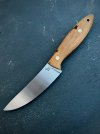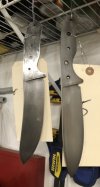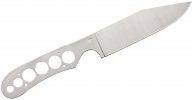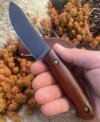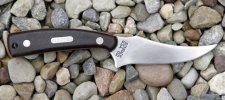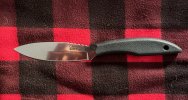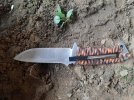reviving this thread a little as I’m now up and running and have pretty much finalized my pattern and have a little write up here. A lot of this below has been said already but I’ll just repeat…I have some photos explaining what I’m saying better too.
This is my field dressing pattern after about 4 years of thinking about what makes a good field dressing knife. Having processed hundreds of animals I’m pretty happy with it. I think I will name this pattern “Skinner Dan”. I’ve gone through an embarrassing amount of variations of it. This info mostly applies to when the animal is on the ground, and not hanging. So an applicable scenario for most people.
It all started when I thought the classic standard drop point was lacking. I noticed during resharpening, the belly portion of the knife was the dullest part. I wasn’t utilizing the full portion of the edge. Also, I’d end up holding the knife halfway back on the handle to get more reach to try and use more of the edge. So what are ways to open up the edge more?
It mostly comes down to increasing blade height, creating more finger and knuckle clearance, or increasing the tip height (trailing point). I prefer a slimmer blade for processing so increasing blade height only gets you so far. Trailing points are good but often it leads to a more acute tip that can be disadvantages around guts (or the hide).
This lead me to finger clearance. I like to analogize cutting up an animal on the ground to cutting something on a cutting board. You need finger clearance (that’s why kitchen knives are so tall) to allow the edge to reach what you’re cutting. If you don’t you only use the front portion of the edge (see photos).
I eventually landed on offset handles. The classic Canadian belt knife comes to mind. It allows more finger clearance while still remaining light and nimble. Bingo.
Some other notes about my specific design.
-gradual sweeping belly line to follow hand motion
-slight dropped tip for strength, less acuity, and ability to slide along quarters/body to remove hide
-neutral (and slim) handle that’s comfortable in multiple hand positions
-I’m aware that you can pretty much get away with any knife cutting up an animal, but a 4” blade in my experience is much more efficient and enjoyable
If you’ve made it this far the last photo (FD3) is my current pattern
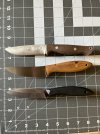
Standard drop point
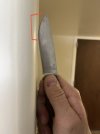
My pattern
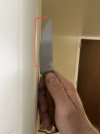
Iterations
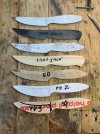
“Skinner Dan” I finished up a few days ago with some local oak brush for scales
